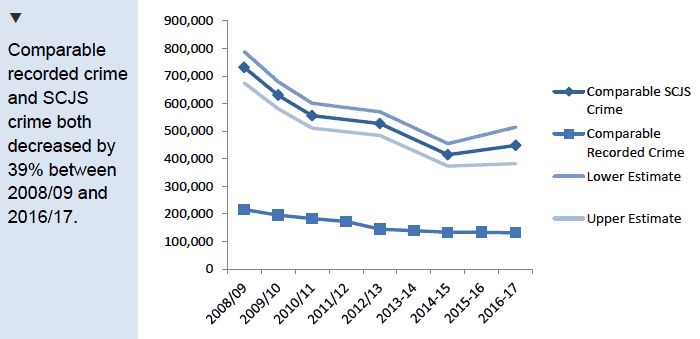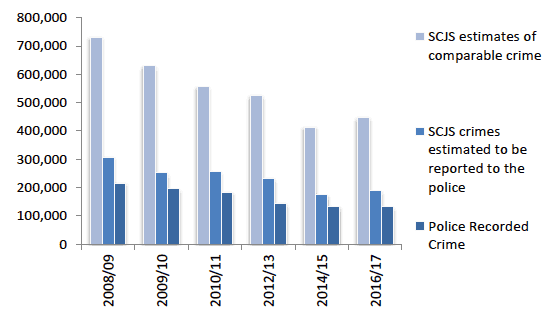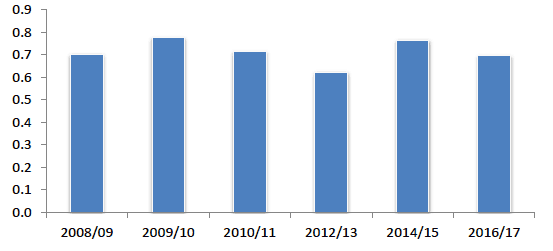Scottish Crime and Justice Survey 2016/17: main findings
This report details the main findings from the Scottish Crime and Justice Survey conducted 2016-2017.
This document is part of a collection
5. Bringing together crime statistics
Why are there two sources of crime statistics?
This chapter compares police recorded crime and the SCJS to help assess the scale of the difference between the volume of crime that is recorded by the police, and the level of crime that is estimated by the survey to be experienced by the adult population in Scottish households. It builds on an analytical paper, published in 2014 (and updated in the 2014/15 SCJS report) and uses a subset of comparable crime to compare SCJS estimates with police recorded crime figures [52] .
A range of information is provided based on analysis of this comparable subset of crime. The two sources of crime statistics are reviewed briefly first, then the chapter looks at trends in these two sources over time and trends in three broadly comparable sub-groups over time (violent crime, acquisitive crime and vandalism [53] ). Finally this chapter compares police recorded crime with the proportion of SCJS crime estimated to have been reported to the police.
The SCJS and Police Recorded Crime are essential, complementary sources that, together, present a fuller picture of crime in Scotland
Crimes recorded by the police provide information on crimes that the police face and are important because they can help to evaluate measures in place to reduce crime, assess the performance of policing and criminal justice organisations and also allow them to use evidence to adequately target resources. However, crime recording is sensitive to changes in public reporting practices, police recording practices and, in part, police deployment and activity. In addition, not all crimes come to the attention of the police.
Crime surveys allow a wider assessment of the overall level of crime and likelihood of experiencing crime and provide a range of additional information, for example on the characteristics of crime, the relative likelihood of experiencing crime across the population and on repeat victimisation. However surveys are often not as good at picking up some rarer crimes, crimes where there is no specific victim or where the victim is not covered by the survey sample; for example, crimes against businesses and children.
In summary, the SCJS and Police Recorded Crime cover different crime and offence groups, different populations and also different timescales. The 2016/17 Recorded Crime results cover crimes recorded in the financial year 2016/17; the 2016/17 SCJS includes crimes experienced by SCJS respondents over a 23-month 'recall period' [54] . They each feature relative strengths and limitations, making them more appropriate in different contexts and for different purposes [55]
Taking account of these differences, comparisons between recorded crime and SCJS data can be made by examining a broadly comparable subset of crimes which are covered by each source, and can be coded in the survey in approximately the same way as they would be recorded by the police. Almost two-thirds (63%) of 'all SCJS crime' as measured by the SCJS 2016/17 falls into categories that can be compared with crimes recorded by the police. The SCJS 2016/17 estimated 42% of comparable SCJS crime was reported to the police.
What are the trends in comparable SCJS and police recorded crime?
There is good consistency in the trends in comparable SCJS and police recorded crime, particularly over the longer term.
Of the 712,000 crimes estimated by the 2016/17 SCJS, almost two-thirds (448,000) can be compared with police recorded crimes. Figure 5.1 demonstrates the scale of the difference between the two series of crime statistics. In 2016/17, the police recorded 131,566 crimes and offences in the comparable subset, representing 29% of the number of crimes in the SCJS comparable subset ( Table 5.1 below).
There are a number of reasons for these differences, including that SCJS estimates tend to be higher than recorded crime figures, even in the comparable category, because the survey is able to capture crime which does not come to the attention of the police. Overall the 2016/17 SCJS estimates that 42% of all crime in the comparable subset came to the attention of the police [56] .
Figure 5.1: Comparable recorded crime and SCJS estimates, 2008/09 to 2016/17

Sources: SCJS, Police recorded crime.
As shown in the table, SCJS comparable crime fell by 39% between 2008/09 and 2016/17 however this has not changed since 2014/15. Comparable recorded crime has also fallen by 39% since 2008/09 and by 1% since 2014/15. It is notable that Her Majesty's Inspectorate of Constabulary in Scotland ( HMICS)'s auditing of incidents and crimes recorded by Police Scotland indicates that police compliance in recording is generally good overall.
Table 5.1: Comparable crime group estimates, 2008/09 to 2016/17
| 2008/09 | 2014/15 | 2016/17 | % change since 2008/09 | % change since 2014/15 | |
|---|---|---|---|---|---|
| Comparable SCJS Crime | 731,000 | 414,000 | 448,000 | -39% | No change |
| Comparable Recorded Crime | 215,901 | 133,170 | 131,566 | -39% | -1% |
| SCJS Acquisitive Crime | 64,000 | 49,000 | 51,000 | No change | No change |
| Recorded Acquisitive Crime | 27,527 | 21,000 | 18,295 | -34% | -13% |
| SCJS Violent Crime | 317,000 | 186,000 | 231,000 | -27% | No change |
| Recorded Violent Crime | 82,855 | 62,578 | 63,246 | -24% | 1% |
| SCJS Vandalism | 350,000 | 179,000 | 166,000 | -53% | No change |
| Recorded Vandalism | 105,519 | 49,592 | 50,025 | -53% | 0% |
Sources: SCJS; Police recorded crime; SCJS Base: 2008/09 (16,000); 2014/15 (11,470), 2016/17 (5,570)
Note: changes specified where statistically significant.
Acquisitive Crime
The acquisitive comparable crime group includes bicycle theft, housebreaking and theft of a motor vehicle. In 2016/17, the SCJS estimated that there were 51,000 acquisitive crimes (+/- 16,000, meaning that the true number of acquisitive crimes in the underlying population is estimated to be between 36,000 and 67,000). The police recorded 18,295 acquisitive crimes in 2016/17.
Recorded acquisitive crime fell by 34% between 2008/09 and 2016/17 and by 13% between 2014/15 and 2016/17. No statistically significant changes were identified in SCJS acquisitive crime across either of these time periods, however this is likely in part due to the smaller sample sizes involved. [57]
Violent Crime
Violent comparable crime includes serious assault, minor assault and robbery. In 2016/17, the SCJS estimated that there were 231,000 violent crimes (+/- 59,000, meaning that the true number of violent crimes in the underlying population is estimated to be between 172,000 and 290,000), while the police recorded 63,246 violent crimes [58] .
Table 5.1 shows that there is greater consistency between trends in the two sources of comparable violent crime data over the longer term. Between 2008/09 and 2016/17, both SCJS estimates and recorded crime violent crime figures have shown a decrease (by 27% and 24% respectively) [59] . Since 2014/15, recorded violent crime has increased by 1%, while the SCJS has shown no change in violent crime.
Vandalism
The vandalism comparable crime group includes motor vehicle vandalism and property vandalism. In 2016/17, the SCJS estimated that there were 166,000 instances of vandalism (+/- 27,000, meaning that the true number of vandalism crimes in the underlying population is estimated to be between 139,000 and 192,000). The police recorded 50,025 vandalism incidents in 2016/17.
There has been relative consistency in the trends in comparable vandalism crime across both SCJS and police recorded crime between 2008/09 and 2016/17. Since 2014/15, there has been no statistically significant change in the SCJS estimate of vandalism, while crimes of vandalism recorded by the police have also also remianed unchanged. Over the longer term, both SCJS estimates and recorded crime figures have been on a downward trend (each decreasing by 53% since 2008/09).
The number of SCJS crimes estimated to have been reported to the police is similar to, but slightly greater than, the number of police recorded crimes.
SCJS respondents are asked whether the police 'came to know about' the crime, either from them or somebody else. This allows comparisons to be made between crime estimated to have been reported to the police in the SCJS, and police recorded crime figures. Although it is not possible to determine on an individual basis whether a crime that the police 'came to know about' was captured in police recorded crime data, this type of analysis can give an indication of the level of crime that goes unreported, and the broad relationship between police recorded crime figures and SCJS estimates. This section looks at this relationship in two ways, by comparing absolute numbers of crimes and then by examining the ratio between the two series.
Figures from the 2016/17 SCJS indicate that of the 448,000 crimes in the overall comparable subset, around 189,000 incidents (42%) were estimated to have been reported to police. In 2016/17, the police recorded 131,566 crimes in the comparable category. It is therefore estimated that around 70% of comparable crime estimated to be reported to the police was recorded by the police in 2016/17. This is similar to the equivalent proportions in recent years.
In addition, as a proportion of all SCJS comparable crimes, the number of comparable crimes estimated to have been reported to the police, and not recorded in police statistics, has been broadly consistent in recent years; 13% in 2016/17 and varying between 9% in 2009/10 and 17% in 2012/13.
While this analysis indicates that a number of crimes which survey respondents say are reported to the police, are not captured and recorded by the police, it is important to note that such comparisons are based on survey estimates over a longer recall period and as such are broadly indicative, rather than directly comparable.
This type of analysis can be extended across the comparable crime sub-groups, where similar results are found. For example, around 98,000 (or 43%) of violent crimes are estimated to have been reported to the police in 2016/17, while the police recorded 63,246 violent incidents. It is therefore estimated that almost two-thirds (64%) of comparable violent crime estimated to be reported to the police was recorded by the police in 2016/17.
Figure 5.2: Recorded crime, SCJS crime and SCJS crime reported to the police, in the set of comparable crimes, 2008/09 to 2016/17

Sources: SCJS; Police recorded crime.
An alternative approach to investigating the relationship between the two sources is to examine the ratio of police recorded crime to the volume of SCJS crime estimated to have been reported to the police. The analytical paper, published in 2014, outlined two methods for calculating this: the first, comparing the biennial SCJS to annual recorded crime figures and the second comparing the biennial SCJS against two financial years of averaged police recorded crime data. This section updates the information using the first method, to compare the now annual SCJS to annual recorded crime figures [60] .
Figure 5.3 shows the ratio between police recorded crime and SCJS crime estimated to have been reported to the police was 70% in 2016/17. Over recent years, this ratio has varied between 62% in 2012/13 and 78% in 2009/10.
Figure 5.3: Ratio between police recorded crime and SCJS crime estimated to have been reported to the police 2008/09 to 2016/17

Sources: SCJS; Police recorded crime.
Contact
There is a problem
Thanks for your feedback